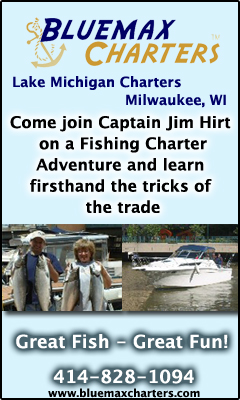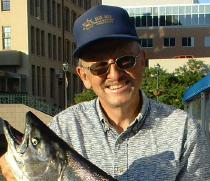In the last article, we started with the importance of location, tackle, temperature and good record keeping. I also covered some of my key ways to find fish in early spring on Lake Michigan and the hot set ups to keep the rods dancing.
Let us now go into more detail on location of temperature breaks and how to work them. The first and perhaps most important is how to find these sometimes subtle temperature changes. Your primary tool, and one you cannot do with out, is a surface temp gauge. I use the one built into my fish locator. It also has a graph to show the temp history over the last hour. This may not be necessary but it can help when mapping temp over a given area. The big pond is very cold in May also some years even into June. Your ability to monitor temp and stay in as close to the target species preferred temp will make or break your day on the lake. Let us assume most of the lake is in the forty-degree range and your target species is Coho, browns or Chinooks. All of these fish are looking for two things, temperature as close to their preferred range and food. I will go into food and or forage in another article for now let’s focus on temperature.
Out of Milwaukee we are fortunate to have several rivers flowing into a large harbor. The rivers warm earlier than the lake and the mouth of a river is a place to start with a temp check. In addition, you should be checking each of the three gaps in the break wall that creates the harbor. A south wind will push the warm water out the north gap. This will turn the fish on in this area while the south gap is too cold for productive fishing. The way I start any day is to work the warmest water or water nearest to preferred temp I can find. After working this water, I move to cooler water. Sharp temp breaks are usually better at holding fish then gradual changes. Always consider the wind direction, not only when you are fishing but what it has been doing over the last several days. A light east wind on our western shore moves warmer surface water on shore and contributes to a rise in temp and a good bite close to the shoreline. All harbors with rivers have some current flow and the wind determines the direction that warmer water will flow when leaving the harbor. Fish that warmer water and into the cooler lake water keeping an eye on your temp gauge. When you get action note your location by land sightings and temp. Stay with that temperature to find active fish. If you have worked the harbor and gaps with no or slow action, look for temp breaks on the lake created by shifts in wind direction.
Another option is to check tight along the shoreline in protected bays. At times I will run my lures in the shallow warmer water on side planners keeping the boat out in the deeper cooler water. Also check out any warm water discharged from power plants. We have this opportunity south of Milwaukee by twelve miles at Oak Creek. I will go into details of spring lure selection and presentation in the next article good luck Jim charters out of Milwaukee, WI. with Blue Max Charters. He can be reached at 414-828-1094 or visit his web site at http://www.bluemaxcharters.com Copyright© 2011, James J. Hirt, All Rights Reserved.
Where do I go?
Milwaukee fishing is as easy as it gets. We truly have a world-class fishery. There are three launch ramps for trailerable boats within minutes of dozens of hotels. McKinley Marina 1750 N. Lincoln Memorial Drive, South Shore Marina 2900 S. Shore Dr. and Riverfront Launch 650 S. Water. McKinley Marina 414-273-5224 can arrange transient slips for those who would like to do an overnight. For general information on ramps and fees call 414-257-6100. Shopping abounds for the ladies who prefer not to fish. Excellent dining, in all price ranges, will make your family outing complete. The Milwaukee Visitor Bureau 800-554-1448 is a great source of information. Wisconsin has a generous daily bag limit on Lake Michigan. You may keep five total of salmon or trout over ten inches. Possession limit is two daily limits. You may use three rods per person.
How do I catch fish?
I would like to share with you some of my keys to finding fish and the hottest set ups for very early presentation. I start my season in early April and the most important factor at this time is temperature. I recommend launching at McKinley. When you come out of the marina, stay inside the break wall. This area is well protected and is always fishable. Proceed south about one mile to the mouth of the river. The best early action will be where the warm river water meets the colder water. The mouth of the river and harbor breakwall gaps is where you want to fish. The most active species will be salmon and Brown Trout in the 5 to 12 pound class with many limit catches.
Presentation?
Motor trolling is the method I use for most of my fishing, and I will explain one of my basic spring setups. I fish all my lines on planner boards with twenty-pound test line. Use a six foot leader 3/8-ounce keel sinker twenty feet behind the board. I recommend a boat speed of 2.0 M.P.H. Run small crank baits, medium size jointed minnow type lures and some spoons. The color of the lure is dictated by the amount of light and water color. On most days in clear water I use white and black or silver lures. Hotter colors work best in cloudy water. You can’t go wrong with chartreuse in both conditions. The new Badger Tackle Vulcan glow in the dark lures sold at http://www.badgertackle.com are an excellent option. Good luck Captain Jim. Jim charters out of Milwaukee, WI. with Blue Max Charters He can be reached at 414-828-1094 or visit his web site at http://www.bluemaxcharters.com Copyright© 2011, James J. Hirt, All Rights Reserved.
Keys For More Action
The start of the 2011 Lake Michigan Season will be here before you know it and now is the time to think about early location and tackle. In this article, I would like to share with you some of my keys to finding fish and the hottest set ups for very early presentation. I have been a charter captain for over twenty years and these techniques have produced year after year. I am confident that you will achieve success applying these classic tips.
Tools You Will Need
I start my season in early April and the most important factor at this time is temperature. I recommend a must item for you is a temp gauge for the surface and a notebook. Your gauge can be a simple hand held thermometer or a unit built into your fish locator. The notebook is all about what’s working and what’s not. I find if I can avoid duplicating non-productive techniques, I will improve my catches and enjoyment. Keeping record of your bad and good days is key to moving to the top of the list as an above average in your sport. I write down the date, time of day, conditions, cloudy, clear, calm, rough, port or lake G.P.S. numbers if you have them. Record this on every fish or at least at the end of the day. On a hot bite, I usually get caught up on my notes as soon as I can to avoid lost detail.
Temperature Temperature Temperature
Spring action can be hot. Think about it, the temperature of the water is in the 40 degree range, and with a few exceptions, the fish we will find the most active are on the top five to ten feet.
Resources
Well lets get started. It’s always a good idea to check local phone hot lines for up to date information on what’s biting. I also check at local tackle stores and Internet reports. You may also call me at 414-828-1094 and check http://www.jimhirt.com for my fish reports. If these resources were not available, I would then start with temperature. This holds true if you are in a boat or on shore. Find the warmest temp you can. Sometimes I am fishing a temp break of only a degree or two. Don’t rush this process. Haste to get your lines in non-productive water is just a waste of time. You will find these temp breaks at mouths of rivers, power plants and protected bays.
Wind Direction
The wind direction will be a major player in warm water location. The surface warms first and wind will move this water around. On Wisconsin’s shore, a light east wind does wonders to improving spring action. The reason I used most of this article on temp is it helps eliminate a lot of slow fishing time. Temperature is almost more important than the type of lure you use.
Set Ups
Motor trolling is the method I use for most of my fishing, and I will explain one of my basic spring setups. If possible I would max out the number of rods, because more is better this time of year. I fish all my lines on planer boards. Find one you like and run all the same type. For lures I like spoons crank baits, and jointed minnow type lures. These will cover most fish. The water is too cold for flasher flies and they will be used when the water warms to over fifty degrees.
Speed & Color
When fishing early in the season, fish metabolism or body temp is very low so a slow presentation is required. I run my boat speed between 1.5 and 2.0 miles per hour. The color of the lure is dictated by the amount of light and water color. On most days, in clear water I use white and black or silver lures. Hotter colors work best in cloudy water. You can’t go wrong with chartreuse in both conditions. The glow in the dark Vulcan or Reaper spoons sold at http://www.badgertackle.com in regular size are an excellent option. The old rule of thumb applies; bright lures bright days, dark lures dark days. I cannot cover all the bases in this limited space so I will go into more detail in future posts. Good luck Captain Jim. Jim charters out of Milwaukee, WI. with Blue Max Charters He can be reached at 414-828-1094 or visit his web site at http://www.bluemaxcharters.com Copyright© 2011, James J. Hirt, All Rights Reserved.





